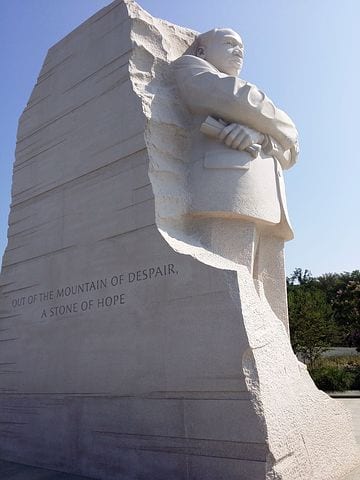The Rev. Dr. Martin Luther King Jr. played a pivotal role as a prominent leader and spokesperson during the Civil Rights Movement. This movement was attributed to the segregation of African-Americans in the 1950s and 60s. According to Forbes, King was inspired by the nonviolent activist Mahatma Gandhi and he combined his Christian values to combat the oppression he felt his community was facing. By presenting rousing speeches such as the famous “I Have a Dream” speech, King outlined his goals and vision of the future of American society: “… I have a dream that my four little children will one day live in a nation where they will not be judged by the color of their skin but by the content of their character.”
King led his vision by organizing peaceful, nonviolent protests such as boycotts and marches. One of his most famous boycotts was the Montgomery Bus Boycott in 1955. After Claudette Colvin and Rosa Parks refused to abide by the Jim Crow laws that enforced racial segregation, King led a boycott of the Montgomery bus system which lasted 385 days, according to Britannica.com. This peaceful protest led to the District Court ruling in Browder v. Gayle, which ended racial segregation of the Montgomery public bus system. These protests were mostly successful at enacting new laws, such as the Civil Rights Act of 1964 and the Voting Rights Act of 1965, improving the lives of many Americans.
 In the late summer of 1962, Washington D.C was ground zero for a March for Jobs and Freedom. King represented the Southern Christian Leadership Conference (SCLC) as the organization’s first president; this is when he gave his famous “I Have a Dream” speech. According to the U.S. National Park Service, the march provided people an opportunity to express their concerns and grievances directly to the nation’s capital. It demanded an end to racial segregation in public schools, proper civil rights legislation, laws that would prohibit the use of racial discrimination in the workforce and protection from police brutality on civil rights activists, to name a few.
In the late summer of 1962, Washington D.C was ground zero for a March for Jobs and Freedom. King represented the Southern Christian Leadership Conference (SCLC) as the organization’s first president; this is when he gave his famous “I Have a Dream” speech. According to the U.S. National Park Service, the march provided people an opportunity to express their concerns and grievances directly to the nation’s capital. It demanded an end to racial segregation in public schools, proper civil rights legislation, laws that would prohibit the use of racial discrimination in the workforce and protection from police brutality on civil rights activists, to name a few.
On April 4, 1968, while standing on his Lorraine motel room balcony in Memphis, Tenn., King was shot by James Earl Ray. King was in Memphis to support the employees of sanitary works, who were on strike for higher wages and improved equal workplace treatment to all races, according to History.com. His sudden assassination caused an uprising across the nation. Shortly after, President Lyndon B. Johnson declared April 7, the day of his funeral, a national day of mourning for the civil rights leader. After King was laid to rest, Congress passed the Civil Rights Act of 1968 which prohibited discrimination in housing based on race, religion or national origin.
According to Time.com, as early as 1971, major cities and states established an annual holiday to honor the late King. Then, in 1986, President Ronald Reagan signed a bill creating the federal Martin Luther King Jr. Day holiday in honor of King, first observed on Jan. 20 of that year. In 1992, President Bush made a change so that the holiday would be observed on the third Monday of January each year in honor of his life and death.
An article written by King’s wife, Coretta Scott King, on TheKingCenter.org stressed the importance of the holiday as we celebrate it today. According to Scott King, “we are called on this holiday, not merely to honor, but to celebrate the values of equality, tolerance and interracial sister and brotherhood he so compellingly expressed in his great dream for America.” Many states use this day as a day of community and service. Martin Luther King Day serves as a day for us, as Americans, to remember a legendary man who questioned the societal norm of racism and worked to end this issue. He stood up for his beliefs and made a major difference in the society we live in today. This year, take a moment to recognize a man who always considered life’s most persistent and nagging question, “what are you doing for others?”


